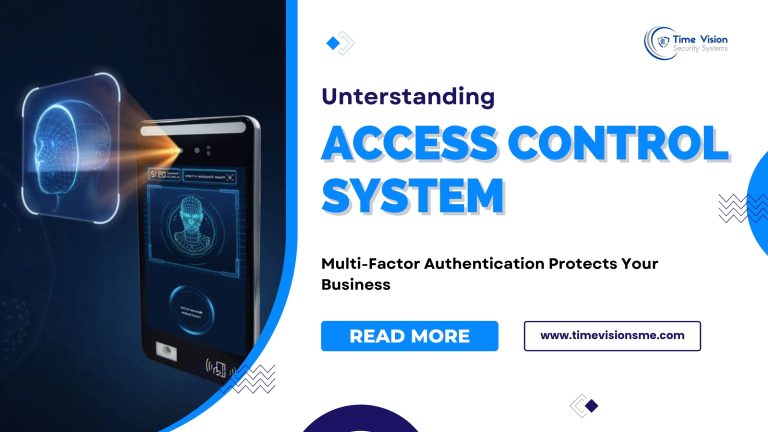
In today’s world, security is more important than ever. Whether it’s your home, office, or any secure facility, controlling who enters and exits is critical. That’s where access control systems come in. These systems help manage entry through various methods like keycards, PINs, and biometric scans.
But with increasing threats and advanced hacking techniques, relying on just one method of access may not be enough. This is why Multi-Factor Authentication (MFA) has become a top choice in modern access control systems.
In this blog, we’ll explain what MFA is, how it works in access control, and why it’s essential for better security.
What Is Multi-Factor Authentication (MFA)?
Multi-Factor Authentication is a security method that requires users to provide two or more verification factors before they are granted access. Instead of relying on just a password or card swipe, MFA adds an extra layer of protection.
Think of it like your bank asking for your card and then sending you an OTP (one-time password) to your phone. Even if someone steals your card, they can’t get in without the second factor.
Why Single-Factor Authentication Isn’t Enough
Most traditional access control systems use just one method – like an RFID card or a PIN. While this may seem secure, it has its risks:
- Cards can be stolen or lost.
- PINs can be shared or guessed.
- Biometric data (like fingerprints) can be copied or spoofed if not secured properly.
With single-factor access, anyone who gets hold of that one credential can enter your premises. MFA helps solve this issue.
Common Factors Used in MFA
To understand how MFA works, let’s look at the types of factors used:
1. Something You Know
- Examples: Passwords, PIN codes
- Simple but can be weak if shared or easy to guess
2. Something You Have
- Examples: RFID card, mobile phone, OTP tokens
- Offers a second layer, but still can be lost or stolen
3. Something You Are
- Examples: Fingerprint, face recognition, palm vein, iris scan
- Harder to fake and unique to each person
Access control systems that use at least two of these are considered MFA-enabled.
Benefits of MFA in Access Control
Enhanced Security
MFA significantly lowers the chances of unauthorized access. Even if one factor is compromised, the second (or third) acts as a safety net.
Reduced Fraud and Buddy Punching
In workplaces, employees can no longer clock in for one another. Using biometrics and a second layer like a card or PIN ensures only the right person gains access.
Audit Trails and Monitoring
Most modern MFA systems generate logs and reports. This helps management see who accessed what area and when, improving accountability.
Peace of Mind
Knowing your building or data center is protected by multiple checks makes everyone feel safer – from employees to customers.
How MFA Works in Access Control Systems
Let’s say you have a Biometric Access Control Device at your office door. Here’s how MFA can work:
- An employee approaches the device
- They scan their fingerprint (biometric)
- The system then asks for a PIN or swipe of their access card
- If both checks pass, access is granted
Devices like the EN-A23(TY) Wi-Fi Access Control System support multiple verification options such as fingerprint, face scan, PIN, and RFID card. These are perfect for setting up multi-factor security at doors.
Best MFA Combinations for Businesses
Choosing the right combination depends on your environment and user base. Here are some popular setups:
Fingerprint + PIN
- Common in offices and educational institutions
- Quick and user-friendly
Face Recognition + RFID Card
- Touchless and hygienic
- Great for hospitals, gyms, and residential buildings
Biometric + Mobile OTP
- For high-security areas like server rooms or research labs
- Combines local access with cloud-based verification
Challenges and How to Overcome Them
Like any technology, MFA in access control has its hurdles:
1. User Resistance
Some employees may find it annoying to go through multiple steps. Educating them about security benefits usually solves this.
2. Cost
Adding more devices or mobile apps can increase setup costs. However, the long-term savings in theft prevention and risk reduction are worth it.
3. Integration
Not all systems are plug-and-play. Choose an access control system that easily integrates with your current setup.
Our experts at Time Vision can help you select the right solution for your business needs.
How to Choose the Right MFA-Enabled Access Control System
Here are some things to keep in mind:
- Support for at least two authentication methods
- Compatibility with your existing doors and infrastructure
- Ability to log and generate reports
- Cloud-based or app control options
- Easy to manage for HR or IT teams
Explore our Biometric Access Control System Installation Service to find models that match your office, villa, warehouse, or retail space.
Where MFA Is Most Useful
- Corporate Offices – Prevent data breaches and unauthorized visitors
- Warehouses – Manage worker access across shifts
- Schools & Colleges – Secure labs, server rooms, and administrative areas
- Apartments/Villas – Allow access only to residents and verified guests
- Government and Financial Buildings – Require multi-layer verification for sensitive zones
Conclusion
Multi-Factor Authentication adds a much-needed layer of protection to traditional access control systems. As threats grow more complex, businesses in the UAE and beyond need smarter security solutions.
By combining biometric methods like fingerprint or face recognition with something you have (like a card) or something you know (like a PIN), MFA helps protect your people, property, and data.
Ready to upgrade your access control system with MFA?
Contact Time Vision Security Systems LLC for expert installation and support.
Also Read:
Why Biometric Access Control Is Important for UAE Businesses
